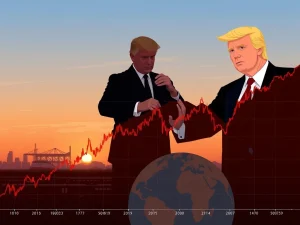US GDP Forecast: Urgent Warning as Betting Markets Predict Negative Growth

Crypto enthusiasts and market watchers are closely monitoring unusual signals emerging from prediction platforms. Users on platforms like Polymarket and Kalshi, typically known for wagering on political events or pop culture, are now making significant bets on the US economy’s future. The surprising news? Their collective wisdom suggests a potential economic contraction for the first quarter of 2025, marking a sharp reversal from recent positive trends. This shift in the US GDP forecast from these unconventional markets is raising eyebrows and prompting questions about the factors driving such pessimism.
Why are Prediction Markets Suddenly Bearish on the US GDP Forecast?
The sentiment on platforms like Polymarket and Kalshi took a dramatic turn recently. On April 29, 2024, Kalshi, a regulated US derivatives exchange, saw its consensus estimate for Q1 2025 US economic growth plunge from around 0.5% positive growth to -0.4% negative growth in under 24 hours. Simultaneously, Polymarket bettors increased the probability of a US economic contraction in Q1 to approximately 70%. This rapid shift suggests a strong reaction among bettors to new information or evolving concerns about the economic outlook.
For context, the US economy has reported positive growth every quarter since 2022. A move into negative territory would signify an economic contraction, potentially signaling the beginning of a recession. The sudden bearish sentiment on these platforms is particularly notable because prediction markets aggregate the views of many participants, and their forecasts have shown accuracy in predicting outcomes in other domains.
Understanding the Power of Prediction Markets
Prediction markets operate on the principle of letting users trade contracts tied to specific future events. The price of a contract fluctuates based on how likely participants believe the event is to occur. Essentially, the market price reflects the crowd’s aggregated probability assessment. These platforms, including Polymarket and Kalshi, provide a real-time gauge of public or participant sentiment regarding future events.
In recent years, event contracts have gained attention for their forecasting accuracy, sometimes rivaling or exceeding traditional polling methods. For instance, prediction markets reportedly forecasted political outcomes like election wins and party control shifts, demonstrating their potential as indicators of future events.
Is Tariff Turmoil Driving Fears of Economic Contraction?
One major factor cited alongside the prediction market shift is the increasing concern over global trade tensions, often referred to as ‘Tariff Turmoil’. Recent announcements regarding potential sweeping tariffs on US imports have created significant uncertainty in the global economic landscape. While some proposed tariffs have been paused for certain countries, the prospect of a wider trade conflict persists.
Macroeconomic data points already suggest this uncertainty is impacting sentiment. For example, the Philadelphia Federal Reserve Manufacturing Index reported significant declines in activity in April, with analysts attributing this cautious stance among manufacturers to concerns about rising production costs potentially resulting from new tariffs.
The timing of the prediction market shift, coinciding with increased discussion around trade policy and related economic indicators, suggests a strong correlation between these concerns and the darkening US GDP forecast among bettors.
Polymarket Kalshi Bettors Weigh In
The combined activity on Polymarket and Kalshi represents a significant pool of capital betting on economic outcomes. While not official economic forecasts, the aggregate positions taken by users on these platforms provide an alternative, market-driven perspective on future events. The charts showing the rapid decline in expected growth percentage on Kalshi and the increasing odds of contraction on Polymarket offer a visual representation of this bearish sentiment taking hold.
It is important to remember that prediction market outcomes reflect the wagers placed by participants and are not guarantees. However, the notable and sudden shift observed on both Polymarket and Kalshi regarding the Q1 2025 US GDP forecast warrants attention from anyone tracking economic indicators and market sentiment.
What Does This Mean and What Should You Watch?
This bearish signal from prediction markets highlights the sensitivity of economic forecasts to factors like trade policy and geopolitical events. While not a definitive prediction, it serves as a warning signal that a significant portion of market participants anticipates an economic contraction.
Key takeaways and things to watch:
- Monitor Official Data: The official report from the US Bureau of Economic Analysis (BEA) on April 30, 2025, will provide the definitive Q1 2025 GDP figure.
- Track Trade Developments: Pay close attention to news and policy announcements regarding tariffs and international trade relations.
- Observe Other Indicators: Keep an eye on traditional economic indicators like manufacturing surveys, consumer confidence reports, and employment data.
- Watch Prediction Markets: Continue to monitor platforms like Polymarket and Kalshi for shifts in sentiment on economic and political events.
The sudden change in the US GDP forecast on prediction markets is a compelling example of how these platforms can capture rapid shifts in sentiment. Whether this prediction of economic contraction materializes remains to be seen, but the signal itself underscores the current fragility and uncertainty surrounding the economic outlook, heavily influenced by ongoing Tariff Turmoil.
Summary: Prediction Markets Flash Red for US Economy
Prediction markets Polymarket and Kalshi have recently shown a stark reversal in sentiment, with bettors now predicting a negative US GDP forecast for the first quarter of 2025. This pessimistic outlook, driven largely by concerns over Tariff Turmoil and potential trade wars, marks a significant shift from previous forecasts of positive growth. While prediction markets are not official economic indicators, their recent track record in forecasting events suggests this signal of potential economic contraction should be taken seriously. Market participants and the public should monitor upcoming official economic reports and trade policy developments closely to understand the evolving economic landscape.








